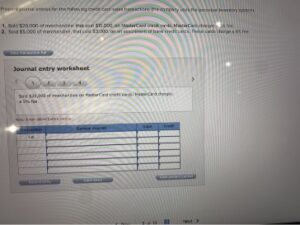The company defines the standard material quantity used for every job. In manufacturing, the unit cost is vital in calculating the final production cost as profit is directly affected. The quantity of material budgeted variance compared to the actual quantity used shows the variance impact on the final cost. The direct materials budget apportions all costs – direct and indirect. If the costs aren’t accurately accounted for, it results in underestimating and overestimating the costs, which causes serious cash-flow problems. Proper management of inventory could lead your business to a profitable or unprofitable trading period.
- While the quantity may differ due to differences in production levels, the prices are more crucial.
- During his time working in investment banking, tech startups, and industry-leading companies he gained extensive knowledge in using different software tools to optimize business processes.
- One more, the favorable variance may arise from the purchase of low-quality material.
- These two factors are accounted for by isolating two variances for materials—a price variance and a usage variance.
COGM is used to determine whether their production costs are high or low than their generated income or revenue. A business uses a software program to track inventory levels and order materials as needed. The program alerts the business when inventory falls below a certain threshold, so they can order more material before running out. Accurate inventory information means avoiding ordering too much or too little of a material, which can lead to wasted time and materials. WIP inventory is crucial since it illustrates the business’s volume of ongoing projects. A company might be unable to satisfy client demand for its items if it has little WIP inventory.
How to Calculate the Cost of Direct Materials Used in Production
Recently, they noticed that the amount of material being used was higher than the amount on hand. They investigated and found that a machine was not working correctly and was causing excess waste. They could repair the machine and reduce the amount of waste going forward. If the manufacturing process is complex or involves a lot of labor hours, the cost of producing the material will be higher. For example, making a car requires a lot of metal and plastic parts that are assembled. This process is more expensive than making a simple toy out of plastic that doesn’t require any assembly.
Best Ways to Lower Cost of Goods Manufactured (COGM) without Compromising Finished Goods Inventory Quality
The formulation is compared against the budgeted cost to determine the cost-effectiveness of a company in producing goods. The LIFO method can help you defer taxes, but very few businesses sell their newest inventory before clearing out older inventory. Businesses employ the weighted average method when they can’t easily separate their stock according to purchase date. This assumes that the demand level exceeds the supply, possibly over an extended period of time.
How to Calculate Direct Materials Cost?
The purchasing department and production manager need to do proper inspect all the material during delivery. The manager may try to overstate it to protect himself from being punished if something goes wrong during the production (unexpected waste or error). However, setting too high standard costs will impact our selling price. Our selling price is higher than the competitors and for sure it will impact the sale quantity.
This could involve streamlining the production process or finding ways to use less material per unit produced. Suppose it’s time to calculate the direct materials inventory for the previous quarter. You use the same formula for your calculations as you do for figuring the ending inventory of sales stock. Add the beginning materials inventory to the amounts purchased during the quarter. For example, say you start the quarter with three tons of steel and buy another ton partway through. That leaves you with an ending inventory of two tons of direct materials.
Next is to establish regular reviews of inventory levels and usage. This can help identify discrepancies in quantities on hand and usage rates, which may indicate that materials are being wasted or not used efficiently. Businesses can save money on direct materials by identifying and addressing these issues. One more, the favorable variance may arise from the purchase of low-quality material.
In this case, the actual quantity of materials used is 0.20 pounds, the standard price per unit of materials is $7.00, and the standard quantity used is 0.25 pounds. This is a favorable outcome because the actual quantity of materials used was less than the standard quantity expected at the actual production output level. With either of these formulas, the actual quantity purchased refers to the actual amount of materials bought during the period. The standard price is the expected price paid for materials per unit. The actual price paid is the actual amount paid for materials per unit.
Companies can easily reduce the cost of goods manufactured by reducing the materials required to produce its product. Materials requirements planning (MRP) is a computer-based production planning and inventory control system. MRP is concerned with both production scheduling and inventory control. It is a vital tool in managing the supply of materials in a manufacturing process.
A standard costing system allows your company to run its operations without waiting for the actual cost order to act. The direct material used and the purchase price are estimated using the available information. After setting the budgeted cost for direct material, the company can plan for purchases and production. The direct materials budget is included in a company’s master budget, which is the budget formed from all other budgets, including sales, production, and direct labor.
The sum of direct material, manufacturing overhead, and labor costs are equal to the production cost. When he begins the project, he will estimate how much of each direct item he needs and the cost of each item. In the procurement process, which is the process of obtaining the materials, he can search for different woods, types of nails, and various types of glue, each of which will entail another cost.
Connie’s Candy paid $2.00 per pound more for materials than expected and used 0.25 pounds more of materials than expected to make one box of candy. Indirect materials are goods https://intuit-payroll.org/ that are part of the entire manufacturing process but are not integrated into the final product. Glue, nails, rivets, and other such items are examples of indirect materials.
With strategic planning, startups can effectively implement standard costing systems for sustained success. Lately, the cost of lumber has been increasing, and the company has struggled to keep its prices competitive. The CEO decided wave app invoicing to explore using different types of wood that are less expensive than the currently used ones. After some research, the company finds a type of wood that is slightly weaker than the original wood but costs significantly less.



